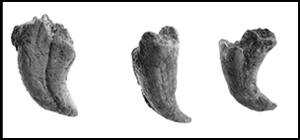Crossref Citations
This article has been cited by the following publications. This list is generated based on data provided by
Crossref.
Robson, Harry K.
Lucquin, Alexandre
Gibbs, Kevin
Saul, Hayley
Tomoda, Tetsuhiro
Hirasawa, Yu
Yamahara, Toshiro
Kato, Hirofumi
Isaksson, Sven
Craig, Oliver E.
and
Jordan, Peter D.
2020.
Walnuts, salmon and sika deer: Exploring the evolution and diversification of Jōmon “culinary” traditions in prehistoric Hokkaidō.
Journal of Anthropological Archaeology,
Vol. 60,
Issue. ,
p.
101225.
Pratt, Jordan
Goebel, Ted
Graf, Kelly
and
Izuho, Masami
2020.
A Circum-Pacific Perspective on the Origin of Stemmed Points in North America.
PaleoAmerica,
Vol. 6,
Issue. 1,
p.
64.
Kudo, Yuichiro
Yoneda, Minoru
and
Omori, Takayuki
2021.
Analysis of carbonized residue adhering to the linear-relief (<i>Ryuki-senmon</i>) pottery excavated from the Hyakunincho 3-chome Nishi site, Tokyo, Japan.
The Quaternary Research (Daiyonki-Kenkyu),
Vol. 60,
Issue. 4,
p.
75.
Morisaki, Kazuki
2022.
What motivated early pottery adoption in the Japanese Archipelago: A critical review.
Quaternary International,
Vol. 608-609,
Issue. ,
p.
65.
Terry, Karisa
2022.
Variable behavioral and settlement contexts for the emergence of ceramic vessels in eastern Siberia.
Quaternary International,
Vol. 608-609,
Issue. ,
p.
137.
Natsuki, Daigo
2022.
Migration and adaptation of Jomon people during Pleistocene/Holocene transition period in Hokkaido, Japan.
Quaternary International,
Vol. 608-609,
Issue. ,
p.
49.
Fitzhugh, Ben
2022.
Maritime Prehistory of Northeast Asia.
Vol. 6,
Issue. ,
p.
349.
Hudson, Mark J.
2022.
Maritime Prehistory of Northeast Asia.
Vol. 6,
Issue. ,
p.
97.
Davis, Loren G.
Madsen, David B.
Sisson, David A.
Becerra-Valdivia, Lorena
Higham, Thomas
Stueber, Daniel
Bean, Daniel W.
Nyers, Alexander J.
Carroll, Amanda
Ryder, Christina
Sponheimer, Matt
Izuho, Masami
Iizuka, Fumie
Li, Guoqiang
Epps, Clinton W.
and
Halford, F. Kirk
2022.
Dating of a large tool assemblage at the Cooper’s Ferry site (Idaho, USA) to ~15,785 cal yr B.P. extends the age of stemmed points in the Americas.
Science Advances,
Vol. 8,
Issue. 51,
Nakazawa, Yuichi
Naganuma, Masaki
and
Tsutsumi, Takashi
2022.
The emergence and transmission of early pottery in the Late-Glacial Japan.
Quaternary International,
Vol. 608-609,
Issue. ,
p.
75.
Hirose, Masato
2024.
Faunal remains of the end of the Incipient Jomon period from Kugo Cave in Gifu, Central Japan.
The Quaternary Research (Daiyonki-Kenkyu),
Vol. 63,
Issue. 3,
p.
183.
Kuzmin, Yaroslav
2024.
Across the Seas in Prehistoric Northeast Asia.
Vol. 2,
Issue. ,
p.
95.
Morisaki, Kazuki
Iizuka, Fumie
Izuho, Masami
Aldenderfer, Mark
and
Spinapolice, Enza Elena
2025.
More on mobility and sedentism: Changes in adaptation from Upper Paleolithic to Incipient Jomon, Tanegashima Island, southern Japan.
PLOS ONE,
Vol. 20,
Issue. 1,
p.
e0314311.



